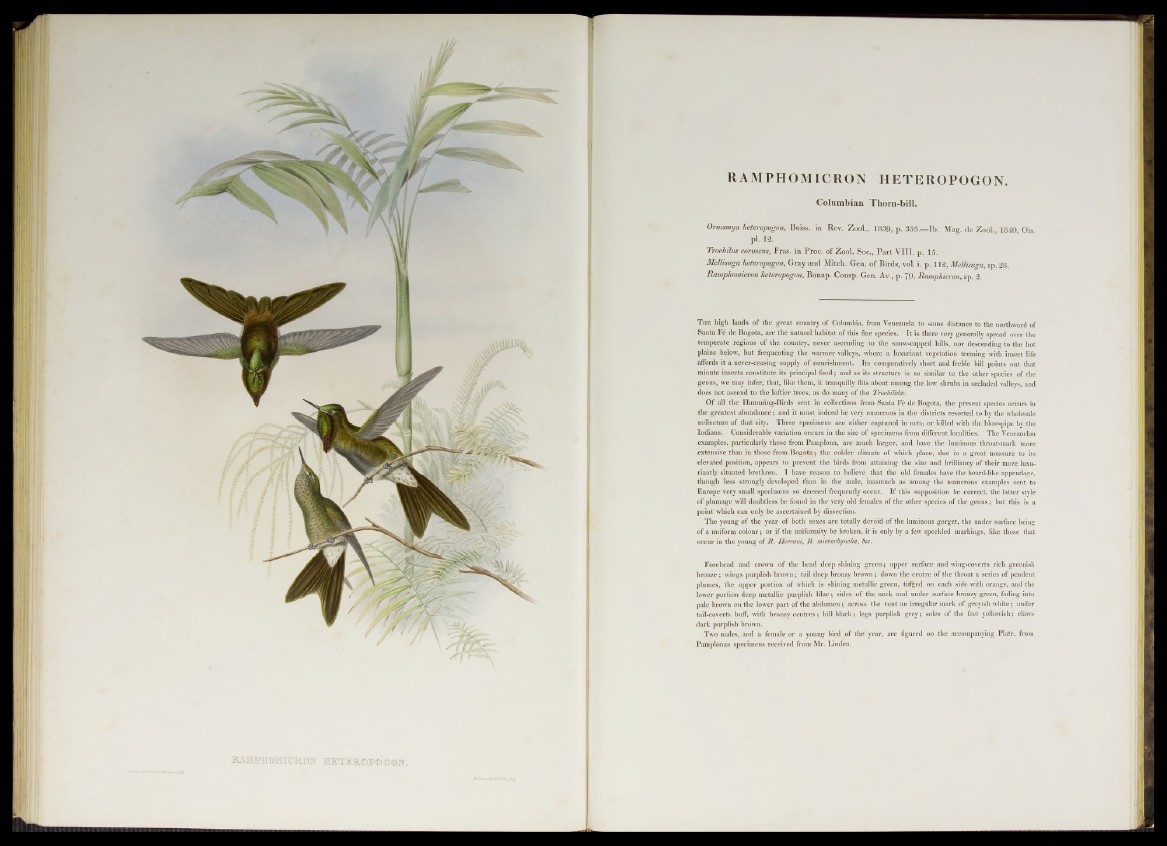
MAMPM©MICM)N HETEIBIOFO G©No
RAMPHOMICRON HETEROPOGON.
Columbian Thorn-bill.
Omismya heteropogon, Boiss. in Rev. Zool., 1839, p. 355.—Ib. Mag. de Zool., 1840, Ois.
pi. 12.
Trochilm contscus, Fras. in Proc. o f Zool. Soc., Part VIII. p. 15.
Mellisuga heteropogon, Gray and Mitch. Gen. o f Birds, vol. i. p. 112, Mellisuga, sp. 28.
Ramphomicron heteropogon, Bonap. Consp. Gen. Av., p. 79, Ramphicron, sp. 2.
T he high lands of the great country of Columbia, from Venezuela to some distance to the northward of
Santa Fe de Bogota, are the natural habitat of this fine species. It is there very generally spread over the
temperate regions of the country, never ascending to the snow-capped hills, nor descending to the hot
plains below, hut frequenting the warmer valleys, where a luxuriant vegetation teeming with insect life
affords it a never-ceasing supply of nourishment. Its comparatively short and feeble bill points out that
minute insects constitute its principal food; and as its structure is so similar to the other species of the
genus, we may infer, that, like them, it tranquilly flits about among the low shrubs in secluded valleys, and
does not ascend to the loftier trees, as do many of the Trochilidce.
Of all the Humming-Birds sent in collections from Santa Fe de Bogota, the present species occurs in
the greatest abundance; and it must indeed be very numerous in the districts resorted to by the wholesale
collectors of that city. These specimens are either captured in nets, or killed with the blow-pipe by the
Indians. Considerable variation occurs in the size of specimens from different localities. The Venezuelan
examples, particularly those from Pamplona, are much larger, and have the luminous throat-mark more
extensive than in those from Bogota; the colder climate of which place, due in a great measure to its
elevated position, appears to prevent the birds from attaining the size and brilliancy of their more luxuriantly
situated brethren. I have reason to believe that the old females have the beard-like appendage,
though less strongly developed than in the male, inasmuch as among the numerous examples sent to
Europe very small specimens so dressed frequently occur. If this supposition be correct, the latter style
of plumage will doubtless be found in the very old females of the other species of the genus; but this is a
point which can only be ascertained by dissection.
The young of the year of both sexes are totally devoid of the luminous gorget, the under surface being
of a uniform colour; or if the uniformity be broken, it is only by a few speckled markings, like those that
occur in the young of R . Herrani, R . microrhyncha, &c.
Forehead and crown of the head deep shining green; upper surface and wing-coverts rich greenish
bronze; wings purplish brown; tail deep bronzy brown; down the centre of the throat a series of pendent
plumes, the upper portion of which is shining metallic green, tilled on each side with orange, and the
lower portion deep metallic purplish lilac; sides of the neck and under surface bronzy green, fading into
pale brown on the lower part of the abdomen; across the vent an irregular mark of greyish white; under
tail-coverts buff, with bronzy centres; bill black; legs purplish grey; soles of the feet yellowish; claws
dark purplish brown.
Two males, and a female or a young bird of the' year, are figured on the accompanying Plate, from
Pamplonan specimens received from Mr. Linden.